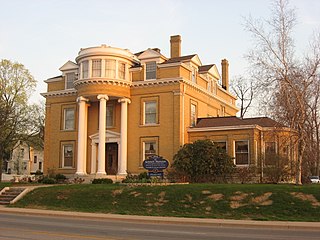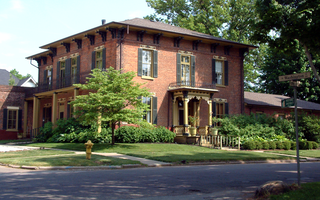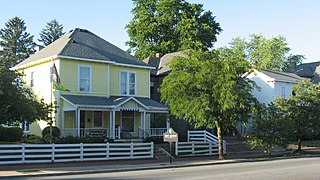
The East Main Street–Glen Miller Park Historic District is a neighborhood of historic residential buildings and national historic district located at Richmond, Wayne County, Indiana. The district encompasses 84 contributing buildings, 11 contributing structures, and 5 contributing objects along the National Road and sometimes called Millionaire's Row. A portion of the district is recognized by the City of Richmond's Historic Preservation Commission as the Linden Hill conservation district. It developed between about 1830 and 1937 and includes representative examples of Italianate, Queen Anne, Colonial Revival, Tudor Revival, Classical Revival, and Bungalow / American Craftsman style architecture. Located in the district is the separately listed Henry and Alice Gennett House. Other notable contributing resources include elaborate iron bridges and "Madonna of the Trail" statue located in Glen Miller Park, Isham Sedgwick House (1884-1885), John A. Hasecoster House (1895), William H. Campbell House (1905), Howard Campbell House (1909), E.G. Hill House, Crain Sanitarium, and Dr. T. Henry Davis House.

Attica Downtown Historic District is a national historic district located at Attica, Fountain County, Indiana. The district encompasses 50 contributing buildings in the central business district of Attica. It developed between about 1840 and 1942, and includes notable examples of Art Deco, Gothic Revival, and Classical Revival style architecture. Notable buildings include the U.S. Post Office (1935) designed by the Office of the Supervising Architect under Louis A. Simon, McDonald House (1840), Revere Hotel (1853), and I.O.O.F Building.

Attica Main Street Historic District is a national historic district located at Attica, Fountain County, Indiana. The district encompasses 36 contributing buildings, 1 contributing site, and 2 contributing structures in a predominantly residential section of Attica. It developed between about 1840 and 1940, and includes notable examples of Late Victorian, Greek Revival, and Federal style architecture. Located in the district is the separately listed Marshall M. Milford House. Other notable contributing resources include McDonald Park, Parker-Clark House, Attica Presbyterian Church (1849), Ziegler House, Rolphing-Colvert Home, "Ladies Library" (1889), former Church of Christ (1891), and Attica Methodist Church (1921).

Brady Street Historic District is a national historic district in Attica, Fountain County, Indiana. The district encompasses 108 contributing buildings, 9 contributing structures, and 4 contributing objects in a predominantly residential section of Attica. It developed between about 1840 and 1930, and includes notable examples of Greek Revival, Gothic Revival, and Italian Villa style architecture. Notable contributing buildings include the Carnegie library (1904), Schlosser House (1840s), Catholic Church (1891) and rectory (1895), McClaflin House (1904), and Greenwood House (1877).

Old East Historic District is a national historic district located at Attica, Fountain County, Indiana. The district encompasses 43 contributing buildings and 2 contributing structures in a predominantly residential section of Attica. It developed between about 1865 and 1930, and includes notable examples of Late Victorian, Tudor Revival, and Italian Villa style architecture. Notable contributing buildings include the Holmes House (1877), Meharry House (1908), Colvert House (1901), and McDermond House (1897).

Covington Courthouse Square Historic District is a national historic district located at Covington, Fountain County, Indiana. The district encompasses 23 contributing buildings in the central business district of Covington. It developed between about 1856 and 1956, and includes notable examples of Gothic Revival, Italianate, Romanesque Revival, Classical Revival, and Art Deco style architecture. Located in the district is the separately listed Fountain County Courthouse. Other notable contributing buildings include the Loeb Building, Old Covington City Building, First National Bank (1913), Knights of Pythias Building (1894), and Covington Post Office (1956).

Brookville Historic District is a national historic district located at Brookville, Franklin County, Indiana. The district encompasses 682 contributing buildings in the central business district and surrounding residential sections of Brookville. It developed between about 1811 and 1913, and includes notable examples of Federal and Greek Revival style architecture. Located in the district are the separately listed Franklin County Seminary and The Hermitage. Other notable contributing buildings include the James Brown Ray House (1811-1820), Old State Bank, James N. Tyner House, Old Brick Meeting House (1810-1821), Franklin County Courthouse (1853-1859), St. Michael's Catholic Church, Howland-Farquahar-Goodwin House (1855), Valley House Hotel (1842), and the Presbyterian Church (1854-1855).

Metamora Historic District is a national historic district located at Metamora, Franklin County, Indiana. The district encompasses 115 contributing buildings and 10 contributing structures in the central business district and surrounding residential sections of the village of Metamora. It developed between about 1838 and 1923, and includes notable examples of Italianate, Gothic Revival, and Greek Revival style architecture. Located in the district is the Duck Creek Aqueduct. Notable contributing buildings include the Odd Fellows Building (1853), Gordon Hall Building, Jonathan Banes House, Metamora Masonic Hall, Martindale House (1838), Metamora Christian Church (1871), Redmen Hall Building, and Farmers Bank of Metamora (1923).

Greenfield Residential Historic District is a national historic district located at Greenfield, Hancock County, Indiana. The district encompasses 523 contributing buildings, 1 contributing site, and 15 contributing structures in a predominantly residential section of Greenfield. It developed between about 1880 and 1947, and includes notable examples of Greek Revival, Gothic Revival, Italianate, Queen Anne, Colonial Revival, Neoclassical, Mission Revival, and Bungalow / American Craftsman style architecture. Located in the district are the separately listed Charles Barr House and James Whitcomb Riley House. Other notable buildings are St. Michael's Catholic Church (1898), Shiloh Primitive Baptist Church, Chair Factory, Friends Meeting House, and two Lustron houses.

Plainfield Historic District is a national historic district located at Plainfield, Hendricks County, Indiana. The district encompasses 174 contributing buildings in the central business district and surrounding residential area of Plainfield. The district developed between about 1840 and 1959 and includes notable examples of Greek Revival, Gothic Revival, Italianate, Queen Anne, and Bungalow / American Craftsman style architecture. Notable buildings include the Ezra Cox House, Oscar Hadley House (1891), Plainfield Carnegie Library (1912), Plainfield Methodist Episcopal Church (1891), Bly Bros. Dry Goods Store, Knights of Pythias Building, Prewitt Theater (1927), First National Bank of Plainfield (1903), Mansion House Hotel (1874), Fisher's Tavern, and Quaker Meeting House (1857-1858).

Drover Town Historic District is a national historic district located at Huntington, Huntington County, Indiana. The district includes 231 contributing buildings, 2 contributing structures, and 1 contributing object in a predominantly residential section of Huntington. It developed between about 1857 and 1930 and includes notable examples of Federal, Greek Revival, Gothic Revival, Italianate, and Queen Anne style architecture. Located in the district are the separately listed German Reformed Church, Samuel Purviance House, and William Street School. Other notable buildings include the William Drover House, John Rhoads House (1896), and Griffiths Block (1896).

Old Plat Historic District is a national historic district located at Huntington, Huntington County, Indiana. The district includes 177 contributing buildings and 2 contributing structures in a mixed residential section of Huntington. It developed between about 1860 and 1920 and includes notable examples of Greek Revival, Gothic Revival, Italianate, and Queen Anne style architecture. Notable buildings include the Mathew Luber House, George W. Humbert House, Trinity Methodist Episcopal Church (1914), First Church of Christ Scientist, and Masonic Temple (1926).

Vincennes Historic District is a national historic district located at Vincennes, Knox County, Indiana. The district encompasses 1,161 contributing buildings, 5 contributing sites, 9 contributing structures, and 37 contributing objects in the central business district and surrounding residential sections of Vincennes. It developed between about 1787 and 1955, and includes notable examples of Federal, Greek Revival, Italianate, and Classical Revival style architecture. Located in the district are the separately listed George Rogers Clark National Historical Park, William Henry Harrison Home, Indiana Territorial Capitol, Old State Bank, and St. Francis Xavier Cathedral and Library. Other notable buildings include the Brouillet House, Knox County Courthouse (1873), Ellis Mansion, Lacy House, Dunn House (1840), Summers House, Fyfield House (1860), Grannan House, Cauthorn House, Gimble-Bond Store (1879), and Rabb House.

Plymouth Northside Historic District is a national historic district located at Plymouth, Marshall County, Indiana. The district encompasses 141 contributing buildings, 2 contributing sites, 6 contributing structures, and 3 contributing objects in a predominantly residential section of Plymouth. It developed between about 1870 and 1940, and includes examples of Italianate, Gothic Revival, Queen Anne, Colonial Revival, Tudor Revival, Neoclassical, and Renaissance Revival style architecture. Located in the district is the separately listed Marshall County Courthouse. Other notable contributing resources include Magnetic Park, First United Methodist Church (1914-1915), J.C. Capron House (1900), Samuel Schlosser House (1910-1911), Clay Metsker House (1917-1918), Plymouth Church of the Brethren (1950-1951), Logan-Stanley Fountain, Stevens House (1895), and First Presbyterian Church (1896-1897).

North Washington Street Historic District is a national historic district located in the city of Bloomington of Monroe County, Indiana. The district encompasses 35 contributing buildings and 6 contributing structures in a predominantly residential section of Bloomington. It developed between roughly 1870 and 1929, and includes notable examples of Queen Anne, Classical Revival, and Bungalow/American Craftsman style architecture. Located in the district is the separately listed Morgan House. Other notable buildings include the Showers-Graham House, Showers-Myers House, Teter House, and Washington Terrace Apartments (1929).

East Washington Street Historic District is a national historic district located at Martinsville, Morgan County, Indiana. The district encompasses 64 contributing buildings, 1 contributing site, and 7 contributing structures in a predominantly residential section of Martinsville. It developed between about 1869 and 1940, and includes notable examples of Queen Anne, Classical Revival, and Colonial Revival style architecture. Located in the district is the separately listed Neely House. Other notable buildings include the Martinsville Presbyterian Church, Sweet House, Gum House, Hubbard-Gano House, Frank Oak Branch House (1916), and Francesconi House.

Albion Courthouse Square Historic District is a national historic district located in Albion, Noble County, Indiana. The district encompasses 61 contributing buildings, 1 contributing site, and 2 contributing structures in the central business district and surrounding residential sections of Albion. It developed between about 1855 and 1964, and includes notable examples of Greek Revival, Gothic Revival, Italianate, Romanesque Revival, Classical Revival, and Art Deco style architecture. Located in the district are the separately listed Noble County Courthouse and Noble County Sheriff's House and Jail. Other notable buildings include the U.S. Post Office (1964), Police Booth, Albion Town Hall (1930), St. Mark's Lutheran Church (1905), United Brethren Church / Masonic Lodge, Presbyterian Church, and Clapp Block / Bank Building.

Cromwell Historic District is a national historic district located at Cromwell, Noble County, Indiana. The district encompasses 33 contributing buildings in the central business district and surrounding residential sections of Cromwell. It developed between about 1875 and 1953, and includes notable examples of Italianate, Queen Anne, Classical Revival, Tudor Revival, and Bungalow / American Craftsman style architecture. Notable buildings include the Edwin Kline-DeMotte House, Forrest Henney/Henney Funeral Home (1910), Hussey House (1901), Kline Building-Maccabee Hall, Sparta State Bank, Smith's Hall/Knights of Pythias Hall (1910), Pret Lung Meat Market (1917), Calvary Lutheran Church (1910), and Biddle's Bakery (1925).

Welborn Historic District is a national historic district located at Mount Vernon, Posey County, Indiana. The district encompasses 154 contributing buildings and 5 contributing structures in a predominantly residential section of Mount Vernon laid out by Jesse Welborn between 1822 and 1826. It developed between about 1840 and 1942, and includes notable examples of Greek Revival, Gothic Revival, Italianate, Romanesque Revival, and Colonial Revival style architecture. Notable contributing buildings include the Gov. Alvin P. Hovey House, Edward Sullivan House (1860), C.P. Klein House Johnson-Rosenbaum House (1905), St. Matthew's Catholic Church (1880), First Presbyterian Church (1872), Trinity Evangelical Church (1883), St. John's Episcopal Church (1892), Mount Vernon Post Office (1931).

Ninth Street Hill Neighborhood Historic District is a national historic district located at Lafayette, Tippecanoe County, Indiana. The district encompasses 88 contributing buildings and 6 contributing structures in a predominantly residential section of Lafayette. It developed between about 1850 and 1946 and includes representative examples of Gothic Revival, Italianate, Queen Anne, Greek Revival, and Second Empire style architecture. Located in the district is the separately listed Judge Cyrus Ball House. Other notable contributing resources include the Samuel Moore House (1891), Moore-Porter-Boswell House (1895), Stanley Coulter House (1890), Edward Bohrer House (1909), Thomas Wood House, Job M. Nash House (1859), and Gordon Graham House.

























